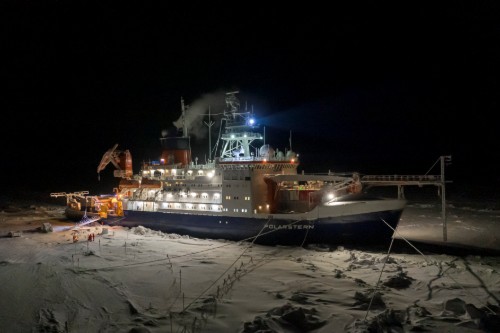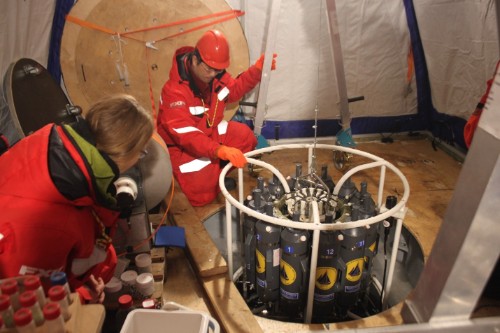
Image shows the German research icebreaker Polarstern moored to an ice floe during the polar night.Steffen Graupner / Alfred Wegener Institute

Image shows scientists retrieving seawater from different depths using a carousel water sampler deployed through a hole in the sea ice.Josefa Verdugo
A new study has shed unprecedented light on the highly variable and climate-sensitive routes that substances from Siberian rivers use to travel across the Arctic Ocean. The findings raise fresh concerns about the increasing spread of pollutants and the potential consequences for fragile polar ecosystems as climate change accelerates.
The international research, published today in Nature Communications and led by the University of Bristol, in the UK, provides the clearest ever picture of how the underlying transport system, known as the Transpolar Draft, operates. It also uncovers the various factors controlling this major Arctic surface current, including warmer temperatures which could increase the spread of human-made pollutants.
The Transpolar Drift carries sea ice, fresh water, and suspended matter from the Siberian shelves across the central Arctic towards the Fram Strait channel, which connects to the Nordic Seas.
This cross-Arctic flow influences the delivery of both natural substances, such as nutrients, gases, organic compounds, and human-made pollutants – including microplastics and heavy metals – from Siberian river systems into the central Arctic and the North Atlantic. This material affects Arctic biogeochemistry and ecosystems, while the fresh water itself alters ocean circulation.
As the Arctic Ocean is a highly changeable environment, rather than following a steady course, river-sourced matter takes diverse, seasonally shifting routes shaped by changing shelf conditions and ocean currents, along with the formation, drift, and melting of sea ice. This results in rapid and widespread redistribution of both natural and pollutant matter.
Lead author Dr Georgi Laukert, Marie Curie Postdoctoral Fellow in Chemical Oceanography at the University of Bristol, UK and Woods Hole Oceanographic Institution in Massachusetts, US, said: "We found pronounced changes in the composition of Siberian river water along the Transpolar Drift, demonstrating this highly dynamic interplay. Seasonal shifts in river discharge and dynamic circulation on the Siberian shelf drive ocean surface variability, while interactions between sea ice and the ocean further increase the redistribution of river-borne matter.
"Another key discovery is the increasingly central role of sea ice formed along the Transpolar Drift – not only as a passive transport medium, but as an active agent in shaping dispersal patterns. This sea ice captures material from multiple river sources during growth, unlike most coastal sea ice, creating complex mixtures that are transported across vast distances."
To decode these complex pathways, the international research team analysed seawater, sea ice, and snow samples using oxygen and neodymium isotopes, along with measurements of rare earth elements to produce geochemical tracer data. This geochemical fingerprinting allowed the researchers to track the origins of river-sourced matter and follow how it evolved along its route through the central Arctic over a year-long period.
The study draws on samples from MOSAiC, the largest-ever Arctic expedition and among the most ambitious polar research efforts, involving seven ice breakers and more than 600 global scientists.
Co-author Dr Dorothea Bauch, Researcher at Kiel University in Germany, said: "The findings represent unprecedented year-round observations. Previously, we only had summer data because it was too slow and hard to break through the ice in the winter. This sustained, interdisciplinary Arctic evidence offers important and comprehensive insights, which help us better understand highly complex ocean systems and the possible future implications."
As summer sea ice continues to retreat due to warmer temperatures, circulation and drift patterns are changing.
Co-author Professor Benjamin Rabe, Research Scientist from the Alfred Wegener Institute and Honorary Professor at the University of Applied Science, in Bremerhaven, Germany said: "These shifts could significantly alter how fresh water and river-derived matter spread through the Arctic, with far-reaching implications for ecosystems, biogeochemical cycles, and ocean dynamics."
The research also challenges a long-standing perception of the Transpolar Drift as a stable conveyor of river water. First observed during Norwegian explorer Fridtjof Nansen's historic Fram expedition in the 1890s, these latest findings discovered more than 130 years later indicate the Transpolar Drift is highly variable in both space and time.
Dr Laukert added: "While the study does not focus on individual compounds, it illuminates the underlying transport mechanisms—a critical step for predicting how Arctic matter transport will evolve in a warming climate. If even this iconic current is so dynamic, then the entire Arctic Ocean may be more variable and vulnerable than we thought."
Paper
'Dynamic ice–ocean pathways along the Transpolar Drift amplify the dispersal of Siberian matter' by Georgi Laukert et al. in Nature Communications.






